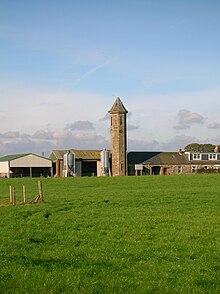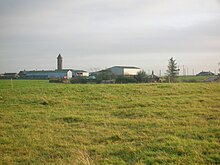Girgenti House
Girgenti House was a country house on a plot of barony Bonshaw in the town of Stewarton in the Scottish management unit East Ayrshire .
history
Bonnyton
Bonnyton , part of the barony Bonshaw had the Reids of Stackawhill and several generations of the family Watt , carpenter and wheelwright heard. That was also Dr. Robert Watt was born, who published the Bibliotheca Britannica shortly before his death in 1824 . It lists over 200,000 books, pamphlets and magazines that were published between 1450 and the beginning of the 19th century. It took Watt 25 years to put them together. His portrait hangs in the entrance hall of the Royal Faculty of Physicians and Surgeons of Glasgow and his direct descendants still live in the Stewarton area today.
Girgenti House
Captain John Cheape , the builder of Girgenti House, was part of that owned by George C. Cheape, Esq. , from Strathtyrum known family from Fife and was the seventh son of James Cheape, Esq. , from Sauchie in Clackmannanshire . He was with the Scots Fusilier Guards and served in the Napoleonic Wars .
Bonnyton (and not Muirhead , as is sometimes claimed) was renamed “Girgenti” by the well-traveled Captain Cheape, perhaps to commemorate a visit to the ancient Greek ruins of Agrigento , whose name has become “Girgenti” in modern Sicilian . In 1827 he paid Thomas Reid £ 1,350 for the property, which totaled 50 Scottish acres (20 hectares). For £ 6,000 he had the old Bonnyton farm demolished, a rather eccentric little country house built with offices, and extensive planting of trees on wild moss. It is not known what prompted him to come to this area and choose such a desolate property. “Moorhead” is the original name Girgenti received in the Lainshaw Register of Sasines .
Cheape spent the last 20 years of his life (1829-1850) in Girgenti House after leaving the army. The house had a vestibule with columns and was basically one-story with yokes , a tower with a roof top and dormers on two different floors. There was also a large summer house. The Ordnance Survey map shows some of the buildings connected to the country house, presumably the farm and a coach house, stables, etc. The National Archives of Scotland has an 1845 map of the property taken by John Fairlie .
Cheape was not married and died on February 10, 1850 at the age of 76. The property has been sold for a number of hospitals across Scotland (Glasgow, Edinburgh, Aberdeen , Inverness and Dundee ). He was buried in the Leigh Kirk in Stewarton. Cheape's only sister, Marianne , who was initially married to Sir Alexander Campbell of Ardkinglass in 1792 , became the third wife of Thomas, 11th Earl of Strathmore and Kinghorne in 1817 . They then lived in Glamis Castle , where Queen Mum later spent a large part of her childhood and where Princess Margaret was born. She should have inherited Girgenti House but died before her brother.
Cheapes tower
Cheape is said to have believed in reincarnation or transmigration of souls; He is said to have been so convinced that he would return to earth in the shape of a bird that he had a tall tower with an octagonal roof built next to the country house, in which a pigeon house was built above . The building, completed in 1843, is 24.3 meters high and has four dials, a coat of arms and the motto “Didus Fractus” (Eng .: let it spread its fruit in the distance), all on the outer facades. A plaque on the tower states that it was "designed and built by Captain John Cheape in 1843". It is said that Captain Cheape would have teamed up with the smugglers and lit a light on top of the tower if he knew the coast was unguarded. The nearby ruins of Auchenharvie Castle and Darnshaw Farm have been linked to the smuggling of bodies by medical students from Glasgow. The tower is very similar to a typical Italian campanile and thus reflects the interest of its builder in Italian culture, as does the name "Girgenti". It is also said that Cheape built the tower so that she could see the sea from there.
Later owners and residents
William Brown , a steel contractor from Glasgow, bought the property after which it came into the hands of Alexander Cochrane of Verreville , Lanarkshire . Later, Allan Gilmour of Eaglesham , a Glasgow businessman, bought the property for his personal use. In the records of the 1881 census, it is noted that the coach house was occupied by James Young of Glasgow and his wife, mother and six children. Christina Fergusson is listed as the laundress in the country house, as is Janetta R. Moffat from Dingwall . In 1900 Girgenti House was sold to the Glasgow Corporation for use as a home for female alcoholics; it was opened in January 1901. (The fact that 71 patients were treated there in 1903 and an average of about 43 lived there shows the extent of the problem at the time.)
After less than ten years as a drunkard home, the property was sold again and converted into a private training center for homeless boys between the ages of 14 and 20. It was next sold to the Scottish Labor Colony Association , which continued to use it as a training center. In 1918 it changed hands again and was used again for agricultural purposes. The owner was now a Mr. Muir , the great-grandson of Thomas Reid from Stackawhill, from whom Cheape had bought the property in 1827.
The farm was then sold in 1932 to a Mr. Sword , Chairman of the Board of Directors of Western Scottish Motor Traction Co. Ltd (bus company), who had a special interest in the outbuildings and had the tower restored and the clocks repaired. The two Italianate style lodges have been preserved to this day, as have parts of the enclosed garden. The country house itself was demolished in the 1940s. The agricultural buildings are mostly original; there is a cottage . From around 1960, Mr and Mrs Smith owned and operated the farm.
Gallery images
Individual evidence
- ↑ a b c James S. Dobie (editor): Cunninghame, Topographized by Timothy Pont A M. 1604-1608, with Continuations and Illustrative Notices by the late James Dobie of Crummock, FSA Scot. John Tweed, Glasgow 1876. p. 102.
- ^ Bibliotheca Britannica by Robert Watt . AbeBooks. Retrieved August 3, 2017.
- ^ Robert Watt: Physician and Bibliographer . In: Journal of the History of Medicine and Allied Sciences XVIII (1) . Pp. 36-50. 1963. Retrieved August 3, 2017.
- ↑ AH Millar: The Castles and Mansions of Ayrshire . Grimsay Press, Glasgow 1885. ISBN 1-84530-019-X . P. 86.
- ↑ a b c d e Dane Love: Lost Ayrshire: Ayrshire's Lost Architectural Heritage . Birlinn, Edinburgh 2005. ISBN 1-84158-356-1 . P. 39.
- ^ Lainshaw Register of Sasines . P. 159.
- ^ Hugh Macintosh: The Origin and History of Glasgow Streets . James Hedderwick & Sons. 1902. Retrieved August 3, 2017.
- ↑ National Archives of Scotland Record RHP14616 ( Memento of the original from July 4, 2011 in the Internet Archive ) Info: The archive link was automatically inserted and not yet checked. Please check the original and archive link according to the instructions and then remove this notice. . Retrieved November 20, 2009.
- ^ Dane Love: Ayrshire: Discovering a County . Fort Publishing, Ayr 2003. ISBN 0-9544461-1-9 . P. 99.
- ^ Girgenti Tower in Ayrshire + Photographs . February 28, 2007 . Retrieved August 3, 2017.
- ↑ Dane Love: Scottish Kirkyards . Robert Hale, London 1989. ISBN 0-7090-3667-1 . P. 148.
- ^ The Gilmours of Eaglesham . ( Memento of the original from September 8, 2008 in the Internet Archive ) Info: The archive link was automatically inserted and not yet checked. Please check the original and archive link according to the instructions and then remove this notice. Retrieved August 3, 2017.
- ↑ 1881 Census . Retrieved August 3, 2017.
- ^ Fergussons in Stewarton area in 1881 Census . Retrieved November 20, 2009.
- ^ Girgenti Reformatory . Retrieved August 3, 2017.
Web links
- Girgenti Farm & Cheape's Tower - Reincarnation and Bodysnatchers . YouTube.
- Girgenti House near Stewarton . SCRAN
- Girgenti Tower . Flickr.
- James Beaton, James Beaton: Watt, Robert (bap. 1774, d. 1819) in Oxford Dictionary of National Biography . Oxford University Press, Oxford 2004.
Coordinates: 55 ° 39 ′ 29.5 " N , 4 ° 35 ′ 58.2" W.








